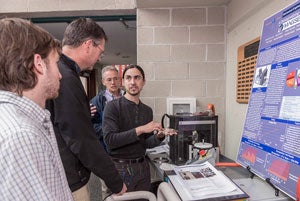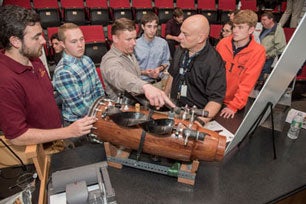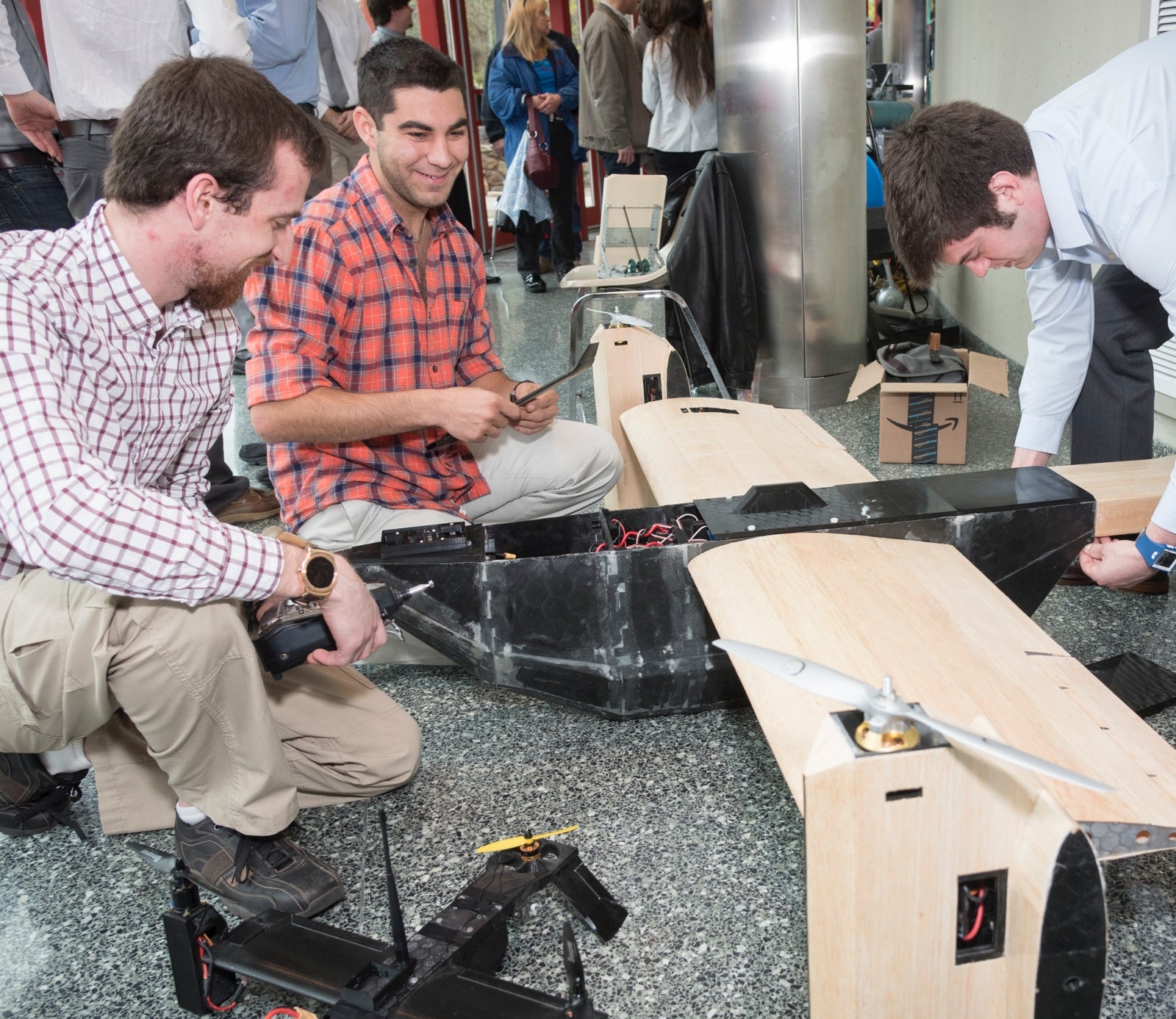KINGSTON, R.I., May 4, 2016—Alex Desilets built his first remote-controlled plane when he was 6 years old. He’s a senior at the University of Rhode Island and still building planes. His latest is the UPLOAD, a drone that takes off and lands on water.
Desilets was one of dozens of URI engineering students who packed into the Kirk Center for Advanced Technology on May 3 to show family, friends, sponsors, faculty and classmates the projects they’ve created over the last year for their senior design capstone class.
“I’ve had a blast doing this,” said Desilets, of South Kingstown. “I’ve been working on this project 40 to 60 hours a week since September, and I don’t regret a second.”
Students said working on a yearlong project is a welcome alternative to cracking the books—and crucial experience for the job search. Employers, they say, are more likely to hire someone with hands-on experience.
Bahram Nassersharif, the URI engineering professor who teaches the class, spent the afternoon traveling from exhibit to exhibit, snapping photos and talking to guests about the “incredible” offerings. The class requires students to solve real-world problems with viable products.
“You can see the level of energy, excitement and enthusiasm here,” said Nassersharif. “These are all great projects. Employers are very interested in what our students are creating. It’s a great way to distinguish URI engineering students.”

Students displayed their projects—and posters—on tables set up in Kirk’s auditorium and hallways. The exhibits also included posters and, for the truly interested, flyers to take home.
Joshua De La Hoz of Warwick and his team came up with MAGSEAL, a more efficient way of demagnetizing magnetic seals so they can be used repeatedly and won’t deteriorate quickly..
“I learned so much,” says De La Hoz. “It’s great to work on something from start to finish. For a mechanical engineer that’s important. I went through every iteration—from start to finish. That’s what engineers love to do.”
Christian Paquette, also of Warwick, helped build a machine that does a better job cutting sheets of plastic and also reduces damage to equipment. He and his team partnered with Toray Plastics of North Kingstown.
“Working on a project like this is different from theoretical book work,” he says. “This gives us a creative experience.”
One team improved the performance of the “mini baja” off-road car and another created a residential wind turbine called WINDFINITY, which can supply power to refrigerators and other household appliances. Other designs included an improved heat exchanger for potable hot water, a device to prevent ice dams in the winter, and a better respooling system for Hope Global, a textile company in Cumberland. (The team’s name was appropriately called “Team All Wound Up.”)

“I think it’s great women are getting into the science fields,” said Jennifer McGunigal of Warwick, one of the engineers on the respooling team. “Engineering has always been my first choice.”
One of the more unusual projects was the RADSUB, a submersible that can inspect the core of nuclear reactors. “For an engineer, it’s important to work with your hands and know how to make a design a reality,” said Matthew Repetto, of Westchester, N.Y. “Engineers sit at computers and design, but it’s also important for us to use our hands.”
Another hit was the Wingman 360, a device that can prevent wingtips on planes from colliding while aircrafts are being towed on the ground.
The 5-pound, plastic device temporarily attaches to a plane’s wingtip with suction cups. Ultrasonic sensors in the device detect when the aircraft is getting too close to another plane on the ground or the wall of a hangar as it’s being towed. The team is collaborating with Delta Airlines.
Delta is so enthusiastic about the project it sent a representative, Tim Files, an aircraft systems analyst, to the event yesterday. Files was excited about the students’ work, which is based on a device created two years ago by another URI mechanical engineering student design team.
“I’m very impressed,” said Files. “Starting from scratch with an idea and bringing it to a tangible device that works—that amazes me. These students are so enthusiastic, so driven, so smart.”
A prototype of Wingman 360 was tested at an airport in Quonset last month. “We did really well,” said Laura Corvese of Portsmouth, who is heading to graduate school at Boston University in the fall to study mechanical engineering and robotics. “It’s been a great experience.”
The drone was a crowd-pleaser. A full-size version was displayed on Kirk’s floor, and Desilets charged up a smaller model at one point. The drone has a hidden drawer that can carry items weighing up to 8 pounds. With that capacity, it can deliver at sea anything from a sandwich to medicine. Desilets intends to spend his summer refining his plane. As far as his career goes, he says, the sky’s the limit.

